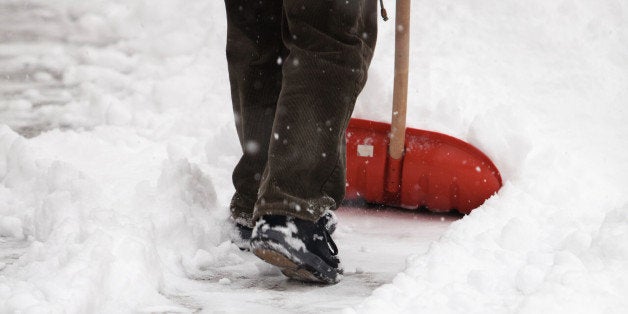
Winter will be here before we know it, and in some parts of the country, that means snow is coming. With snow comes snow shoveling injuries, many of which are avoidable. Approximately 11,500 people are treated in hospital emergency rooms for injuries that happened while shoveling or removing ice and snow manually. More serious dangers resulting from snow shoveling are reported, namely acute myocardial infarction and sudden coronary death.
Here are some of the most common things people do incorrectly when shoveling snow, and what you can do to prevent injury.
1. You aren't warming up first.
You might not think you need to warm up before shoveling snow. After all, it's not as though you're going to run a mile or play a football game. However, shoveling snow is physically demanding, and you'll find the work a bit easier by getting your blood flowing. You're also less likely to strain your muscles if you stretch out, rather than just going outside and shoveling. If you have access to a treadmill or stationary bike indoors, 5-10 minutes at low intensity should get the muscles loosened up.
2. You're not using the right gear.
Using your garden shovel that came in handy while planting flowers last spring? If so, you may want to invest in some new gear. People often use a shovel that is too big or too small, which leads to extra strain on the back, glutes, and rest of the lower body. Your shovel handle needs to be the right length for you -- not too long or too short for you to use comfortably without having to bend excessively.
While it sounds obvious, make sure your shovel isn't too heavy. If you find it's already on the heavy side before you add snow, a lighter shovel may be worth the investment. Try a shovel with a sturdy plastic blade to reduce weight and load. Advertising and sales of "ergonomic" shovels are a big business this time of year for good reason. Serious shovelers realize the "one-size-fits-all" concept doesn't fit well here, given the strenuous exertion it takes to clear the path.
Dress warmly. By keeping your body warm with proper cold weather apparel, the flow of blood to your heart, lungs, and muscles is less likely to become constricted. You'll also want to make sure you're wearing boots or shoes with good traction. People often wear shoes that aren't slip-resistant, which can lead to a fall on the slippery snow. Another tip, try putting down sand, rock salt, or cat litter on the sidewalk and driveway to increase the traction. Salt has the added benefit of melting some snow.
3. You're ignoring laws of physics.
Let physics work on your side for a change! Push your shovel into the snow to grab it. Depending on where the snow needs to go, you may be able to use your shovel to push the snow aside. This saves your back the strain of having to lift it as you dump snow to the side (hopefully not in your neighbor's backyard). However, if some heavy lifting is required, keep reading...
4. You aren't using proper lifting techniques.
Improper lifting techniques put you at a greater risk of back injury. Bend your knees, keeping your feet apart and your back straight, as though you are in a squatting stance. Avoid bending at the waist, and use your legs to do the lifting. By keeping your elbows and knees slightly flexed, you will effectively reduce fatigue in the arms, legs, and back. When dumping the snow (not on your neighbor's car either), walk over to the area, bending again to place the snow in the new location. Avoid twisting the back or throwing the snow over your shoulder or to the side -- this puts unnecessary strain on the back.
5. You're starting too late.
Generally, the earlier you start shoveling, the easier the job will be. The longer you wait, the more the snow can pile up and be packed in heavily, making it more difficult for you to shovel. If the snow is deep, remove a little off the top at a time, rather than trying to shovel the whole amount all at once. Try to take a small break every 15 minutes, or sooner if you are starting to feel tired. You can use the time to sip on hot chocolate while perusing the internet for a company to hire so that this entire article becomes irrelevant.
But seriously, with these tips, you should find that you have less back pain when shoveling snow. Listen to your body -- if you are feeling strained or tired, it's time to take a break. It's better to take the extra time to prepare yourself and do it the right way than to spend weeks with a hurt back.
I wish you all a safe and happy winter season!